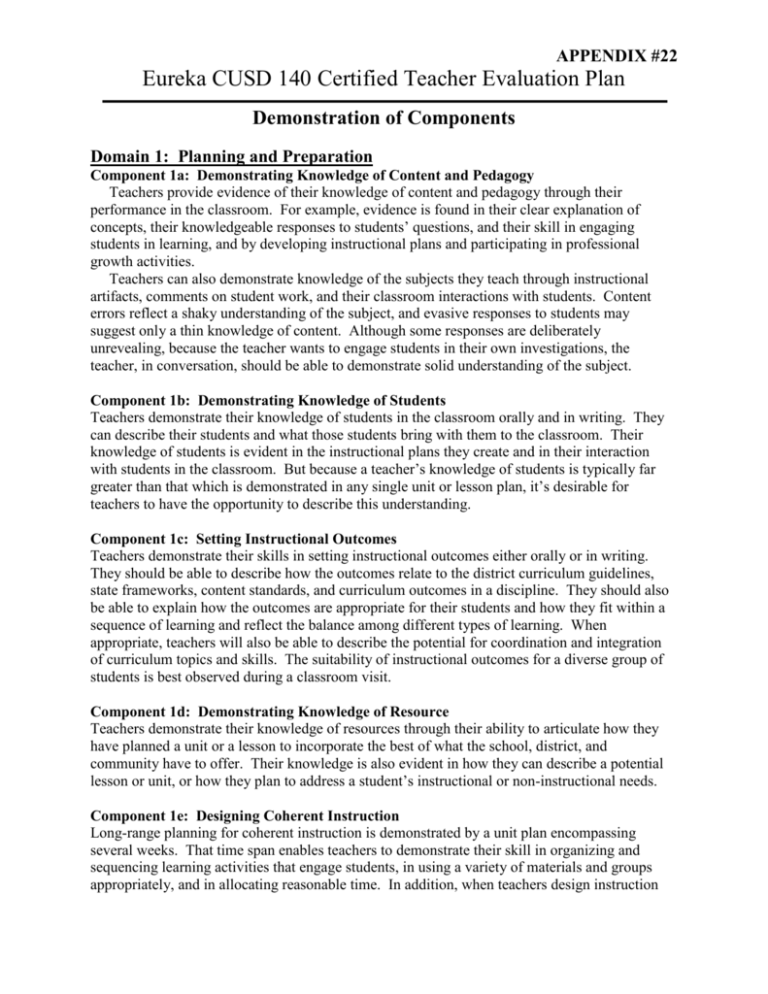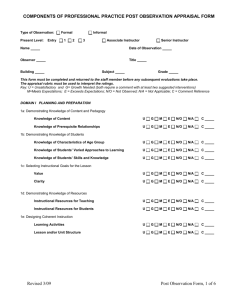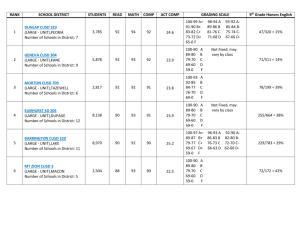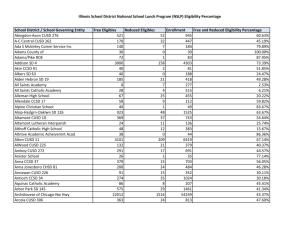Eureka CUSD 140 Teacher Evaluation Plan
advertisement

APPENDIX #22 Eureka CUSD 140 Certified Teacher Evaluation Plan Demonstration of Components Domain 1: Planning and Preparation Component 1a: Demonstrating Knowledge of Content and Pedagogy Teachers provide evidence of their knowledge of content and pedagogy through their performance in the classroom. For example, evidence is found in their clear explanation of concepts, their knowledgeable responses to students’ questions, and their skill in engaging students in learning, and by developing instructional plans and participating in professional growth activities. Teachers can also demonstrate knowledge of the subjects they teach through instructional artifacts, comments on student work, and their classroom interactions with students. Content errors reflect a shaky understanding of the subject, and evasive responses to students may suggest only a thin knowledge of content. Although some responses are deliberately unrevealing, because the teacher wants to engage students in their own investigations, the teacher, in conversation, should be able to demonstrate solid understanding of the subject. Component 1b: Demonstrating Knowledge of Students Teachers demonstrate their knowledge of students in the classroom orally and in writing. They can describe their students and what those students bring with them to the classroom. Their knowledge of students is evident in the instructional plans they create and in their interaction with students in the classroom. But because a teacher’s knowledge of students is typically far greater than that which is demonstrated in any single unit or lesson plan, it’s desirable for teachers to have the opportunity to describe this understanding. Component 1c: Setting Instructional Outcomes Teachers demonstrate their skills in setting instructional outcomes either orally or in writing. They should be able to describe how the outcomes relate to the district curriculum guidelines, state frameworks, content standards, and curriculum outcomes in a discipline. They should also be able to explain how the outcomes are appropriate for their students and how they fit within a sequence of learning and reflect the balance among different types of learning. When appropriate, teachers will also be able to describe the potential for coordination and integration of curriculum topics and skills. The suitability of instructional outcomes for a diverse group of students is best observed during a classroom visit. Component 1d: Demonstrating Knowledge of Resource Teachers demonstrate their knowledge of resources through their ability to articulate how they have planned a unit or a lesson to incorporate the best of what the school, district, and community have to offer. Their knowledge is also evident in how they can describe a potential lesson or unit, or how they plan to address a student’s instructional or non-instructional needs. Component 1e: Designing Coherent Instruction Long-range planning for coherent instruction is demonstrated by a unit plan encompassing several weeks. That time span enables teachers to demonstrate their skill in organizing and sequencing learning activities that engage students, in using a variety of materials and groups appropriately, and in allocating reasonable time. In addition, when teachers design instruction APPENDIX #22 Eureka CUSD 140 Certified Teacher Evaluation Plan for individual lessons, all the characteristics of long-range planning—purposeful activities, appropriate materials and student groups, and coherent structure—are displayed, albeit on a smaller scale. Component 1f: Designing Student Assessment Teachers demonstrate their skill in designing student assessment through the plans they create. With respect to assessment of learning, a unit plan should include the method to be used to assess student understanding, including, if appropriate, a scoring guide or rubric for evaluating student responses. When teachers also include assessment for learning in their plan, then the details of such assessments should be part of the plan. In addition, teachers should be able to explain how they intend to use assessment of learning in their instruction, and how they plan to include students in assessment activities. APPENDIX #22 Eureka CUSD 140 Certified Teacher Evaluation Plan Domain 2: The Classroom Environment Component 2a: Creating an Environment of Respect and Rapport Teachers demonstrate skill in establishing an environment of respect and rapport through their words and actions in the classroom. Occasionally, interaction with a student, or student interactions with one another, may require that a teacher offer an explanation so that an observer can fully understand the teacher’s actions. Such explanations can take place in a discussion following the class. Component 2b: Establishing a Culture for Learning Evidence of a culture for learning is found primarily in the classroom itself, where it’s evident from the look of the room (which may display student work), the nature of the interactions, and the tone of the conversations. The teachers’ instructional outcomes and activities, as described in their planning documents, also demonstrate high expectations of all students for learning. Conversations with students reveal that they value learning and hard work. Component 2c: Managing Classroom Procedures Evidence for how teachers manage classroom procedures is obtained through classroom observation. If asked, students would be able to describe the classroom procedures. In addition, teachers can explain their procedures, how they have been developed, and how students were involved in their creation and maintenance. Component 2d: Managing Student Behavior A teacher’s skill in managing student behavior can only be observed in the classroom. Standards of conduct, however, must frequently be inferred, because in a smoothly running classroom an observer may not witness explicit attention to those standards. Rather, student behavior indicates that a teacher has established standards at the beginning of the year and has maintained them consistently. Although most teachers can articulate their approach to standards of conduct, implementation is critical. In a well-managed classroom, students themselves will be able to explain the agreed-upon standards of conduct. Component 2e: Organizing Physical Space Teachers’ use of the physical environment can be observed or illustrated on a sketch of the classroom. Teachers may be able to explain how they enhance the physical environment and use it as a resource for learning, but implementation is essential. APPENDIX #22 Eureka CUSD 140 Certified Teacher Evaluation Plan Domain 3: Instruction Component 3a: Communicating with Students Teachers demonstrate the clarity and accuracy of their communication primarily through classroom performance. The evidence is not, of course, whether an explanation, for example, is clear to an observer; it must be clear to the students. Watching the students’ reactions provides the best indication of whether that goal has been achieved. Component 3b: Using Questioning and Discussion Techniques Teachers demonstrate their skill in questioning and discussion techniques almost exclusively in classroom observation. The initial questions used to frame a discussion should be planned in advance, however, and will be part of the planning documents. Component 3c: Engaging Students in Learning Teachers demonstrate their skill in engaging students in learning through their conduct of lessons, which may be observed. In addition, the degree of student engagement is revealed through the analysis of student work in response to a well-designed assignment. Component 3d: Using Assessment in Instruction A teacher’s use of assessment in instruction is sometimes evident during a classroom observation, depending on the activities planned for a lesson. Moreover, in discussing a lesson, teachers will be able to explain the point at which they knew that a student was confused, and how they responded. Feedback may be demonstrated through samples of student work with teacher or peer comments. The timeliness of feedback and student use of feedback to engage in further learning can also be revealed through student responses to a questionnaire, particularly at the secondary level. Component 3e: Demonstrating Flexibility and Responsiveness Flexibility and responsiveness can be observed when they occur in a classroom. In addition, a teacher may describe such an event when discussing a lesson after the event. Of course, in many lesson, no such opportunities arise. Their absence is no necessarily a sign of rigidity; rather, it may simply reflect either successful planning or a lack of opportunity. APPENDIX #22 Eureka CUSD 140 Certified Teacher Evaluation Plan Domain 4: Professional Responsibilities Component 4a: Reflecting on Teaching Teachers demonstrate their skill in reflection through professional conversation with colleagues. In some situations, a written reflection may encourage more thoughtful results. Component 4b: Maintaining Accurate Records Teachers demonstrate their skill in maintaining accurate records through artifacts, such as a grade book, skills inventories, results of student assessments, and records of classroom noninstructional activities. Component 4c: Communicating with Families Teachers can demonstrate their communication with families in many ways, such as by keeping copies of such things as class newsletters, handouts for back-to-school night, or descriptions of a new program. This collection could include guidelines for parents on how to review a child’s portfolio or how to encourage responsible completion of homework. In addition, the teacher might maintain a log of phone and personal contracts with families. Component 4d: Participating in a Professional Community Teachers demonstrate their participation in the professional community through their actions. Some teachers maintain a record of their involvement, and the contributions they have made, in the form of a log. Component 4e: Growing and Developing Professionally Teachers demonstrate their commitment to ongoing professional learning through the activities they undertake. These may be recorded on a log. The benefit of keeping such a record is that it invites teachers to reflect on how they have used the new knowledge in their teaching. Such a log can, and should, include informal as well as formal activities—for example, observing colleagues or participating in a project with a professor at a local university. Component 4f: Showing Professionalism Teachers display their professional ethics in daily interaction with students and colleagues. Source: Enhancing Professional Practice: A Framework For Teaching 2nd Edition Charlotte Danielson








